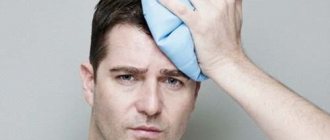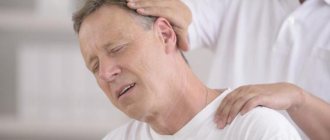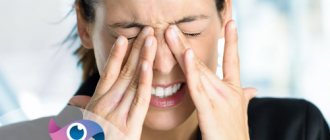home
/
Branches and centers
/
Headache Treatment Center
/
Overuse headache (Headache caused by excessive medication)
Branches and centers
Treatment methods
Diagnostic methods
Diseases and symptoms
Frequent headaches are a good reason to immediately contact a neurologist. Otherwise, you can miss the onset of a serious illness or lead yourself to the development of an abusive headache. Most patients suffering from chronic daily headaches overuse tranquilizers, analgesics, and combination drugs that include codeine and barbiturates. It is due to the frequent use of analgesics that abuse headaches develop. Translated from English, “abuse” means abuse.
Description of the disease
Overuse headache occurs due to long-term use of painkillers and sedatives. In addition to painful sensations, this pathology is dangerous because it changes the initial picture of the disease, which blurs the clinical picture and leads to treatment errors. Changing the pattern of primary headaches may lead to changes in therapeutic methods, which will not cure the underlying cause. The patient will fight the investigation.
In addition, uncontrolled and long-term use of analgesics and tranquilizers leads to the development of diseases of other organs and systems: circulatory, gastrointestinal tract, kidneys, liver.
Important! Overuse headache can develop exclusively in patients suffering from frequent headaches. Under other circumstances, even with long-term use of similar drugs, this pathology does not develop.
Development mechanism
The abuse factor most often forms over a fairly long period of time. Pathogenesis directly depends on the psychological component, as well as on the type of pharmacological agent used. Most often, inadequate and unjustified use of medications begins with depression and increased anxiety. There is also a hereditary predisposition to the manifestation of abuse, depression, alcoholism, etc. The patient does not realize that long-term use of analgesics significantly reduces their effectiveness. This forces the patient to take medications more and more often, increase doses, and taking medications becomes a “way of life.” In this case, the pain is not completely relieved or the attack returns after a short period of time, which leads to the formation of pathological dependence. The fact that primary cephalalgia transforms into chronic is associated with the nociceptive system of the brain, which is responsible for pain perception.
Symptoms
The symptoms of abusive headaches depend mainly on which drug was most often used to relieve pain. Overuse syndrome develops three or more months after taking high doses of analgesics and/or ergotamine.
Characteristic symptoms:
- The intensity of pain is observed in the first hours after waking up, i.e. in the morning.
- Abuse pain is daily in nature and feels like a dull, squeezing pain. Sometimes turning into migraine-like or tension pain - squeezing/tightening.
- In most cases, the pain is moderate.
- Increased pain is observed with physical or mental stress.
- The culmination of pain is associated with the cessation of the use of habitual analgesics.
- The peak of pain may be accompanied by sound and photophobia, nausea, and sometimes vomiting.
- The pain relief effect of the drugs is short-lived
Additional symptoms:
- constant feeling of fatigue;
- decreased performance;
- fast fatiguability;
- sleep disturbances, problems falling asleep;
- irritability;
- "fog" in the head.
What is menstrual migraine?
In women, migraines are often associated with the menstrual cycle. Such attacks occur two days before the onset of menstruation or within three days after the onset of menstruation in at least two out of three cycles. This is how menstrual migraine is described in the III International Classification of Headaches. With “pure” menstrual migraine, attacks occur at the beginning of menstruation, and not on any other days of the cycle. With menstrually associated migraine, attacks can occur on any day of the cycle.
Causes
The main, and perhaps the only reason why patients develop an overuse headache is the uncontrolled use of medications or an unauthorized increase in the dose of painkillers recommended by the attending physician. Regular use of analgesics leads to the development of abusive pain. This is a secondary disease that appears against the background of untreated headaches or abuse of prescribed drugs.
Based on 29 studies of more than 2,500 patients, Diener and Tfelt-Hansen concluded that in more than 65% of cases migraine pain is caused by an overuse factor, about 25% suffer from tension pain and approximately 10% remain with mixed pain. According to statistics, women are 3.5 times more likely than men to suffer from the abuse factor. Keeping a special diary allows you to identify the real number of hundreds of tablets consumed. These numbers are different for each patient, ranging from 2 to 25 pieces per day. The average figure is 5 tablets. In more than half of all cases, patients use over-the-counter forms of drugs, only a third of them turn to specialists in a timely manner.
The abuse factor is characterized by a peculiar course; at the beginning of the disease, patients use mainly paracetamol and aspirin, after a while, resorting to complex analgesics, which include:
- coedeine
- tranquilizer
- ergotamine
- caffeine
- barbiturate.
There are cases of frequent use of pentalgin. Drug abuse is considered recognized when combined analgesics are used more than 10-12 times a month for 3 months or more, and simple analgesics more than 15 times a month. The diagnosis is considered confirmed when taking medications more than 15 days within one month.
BRIEF INSTRUCTIONS FOR MEDICAL USE OF THE MEDICINE RELPAX®.
International nonproprietary name: eletriptan. Pharmacotherapeutic group: antimigraine drug. Pharmacological properties: Relpax® (eletriptan) is a representative of the group of selective agonists of serotonin vascular 5-HT1B and neuronal 5-HT1D receptors. Eletriptan also has a high affinity for 5-HT1F serotonin receptors, which may be relevant to its antimigraine mechanism of action. The ability of eletriptan to constrict intracranial blood vessels, as well as its inhibitory effect on neurogenic inflammation, may contribute to its antimigraine activity. Indications for use: Relief of migraine attacks with or without aura. Contraindications: Hypersensitivity to eletriptan or any other component of the drug. Severe liver dysfunction, age under 18 years. Concomitant use with CYP3A4 inhibitors (ketoconazole, itraconazole, erythromycin, clarithromycin, josamycin) and protease inhibitors (ritonavir, indinavir, nelfinavir). Uncontrolled arterial hypertension, coronary artery spasm, coronary heart disease (angina pectoris, Prinzmetal angina, previous myocardial infarction, confirmed asymptomatic myocardial ischemia) or suspicion of its presence, arrhythmias, heart failure, occlusive peripheral vascular disease, cerebrovascular accident or transient ischemic attack in medical history. Concomitant use with other 5-HT1 receptor agonists. Do not take ergotamine or ergotamine derivatives, including methysergide, within 24 hours before or after taking eletriptan. Relpax ® is not indicated for the relief of hemiplegic, ophthalmoplegic or basilar migraine. Side effects: In general, Relpax ® is well tolerated; side effects are usually transient, mild or moderate, and go away on their own without additional treatment. Nervous system disorders (common): drowsiness, headache, dizziness, muscle hypertonicity, hypoesthesia, myasthenia gravis, sensitivity disorders. Infections (common): pharyngitis and rhinitis. Hearing and balance disorders (common): vertigo. Cardiovascular system disorders (common): palpitations, tachycardia. Respiratory, thoracic and mediastinal disorders (common): a feeling of “tightness” in the throat. Digestive system disorders (common): abdominal pain, nausea, dry mouth, dyspepsia. Skin and subcutaneous tissue disorders (common): increased sweating. Musculoskeletal, connective and bone tissue disorders (common): back pain and muscle pain. General disorders (frequent): feeling of warmth or “hot flashes” to the face, chills, asthenia. Special instructions: Relpax ® should not be used within 72 hours after completion of treatment with CYP3A4 isoenzyme inhibitors. With the simultaneous use of Relpax and SSRIs (fluoxetine, paroxetine, sertraline) and SNRIs (venlafaxine, duloxetine), the development of potentially life-threatening serotonin syndrome is possible. With caution: Use of the drug at a dose above 40 mg in patients with impaired renal function. Directions for use and dosage: Inside. The tablets should be swallowed whole with water. When a migraine headache occurs, Relpax ® should be taken as early as possible, but the drug is also effective at a later stage of a migraine attack. The recommended starting dose is 40 mg. If migraine headache recurs within 24 hours, Relpax can be re-prescribed at the same dose. If a second dose is necessary, it should be taken no earlier than 2 hours after the first dose. The daily dose should not exceed 160 mg. Release form: film-coated tablets 20 and 40 mg. Storage conditions: at a temperature not exceeding 30ºС, out of the reach of children. Effect on ability to drive: In some patients, migraine or taking serotonin 5-HT1 receptor agonists, including eletriptan, may be accompanied by drowsiness or dizziness. When driving a car or working with complex equipment, caution should be exercised during migraine attacks and after taking Relpax ® . Shelf life : 3 years, do not use after expiration date. Conditions for dispensing from pharmacies: by prescription. Before prescribing the drug, read the complete instructions for use of the drug for medical use P N014827/01.
PP-REP-RUS-0214 05/24/2021
Interested in the article? You can find out even more in the Educational program section
Consequences
Any disease that is not treated in a timely manner has its consequences for a person. In some cases, the consequences are minimal and go away with proper therapy. Sometimes it happens that a seemingly “frivolous” disease, like a snowball, gains momentum, turning into truly catastrophic consequences for a person. In the case of the abuse factor, sleep disturbances and increased headaches are noted, nausea appears and excessive anxiety appears.
These symptoms last from several hours to 6-8 days, depending on the severity of the initial condition. Therefore, doctors recommend taking care of sick leave or a short vacation in advance during treatment. This measure will allow you to endure the withdrawal of painkillers and sedatives in the most comfortable conditions and without additional stress. As a rule, 2 weeks after stopping medications that provoke abuse factor, the intensity of headaches decreases by more than 50%.
Diagnostics
Often, diagnosing the abuse factor is difficult, since this type of pain can manifest itself individually in each patient. However, there are general criteria on the basis of which laboratory and diagnostic tests are carried out. Diagnostic methods include a comprehensive neurological examination, including the following procedures:
- Doppler ultrasound of the vessels of the brain and cervical spine;
- ECHO-encephalography;
- rheoencephalography;
- electroencephalography;
- magnetic resonance imaging of the brain;
- computed tomography of the brain;
- radiography of the skull;
- laboratory research;
- fundus examinations;
- specialist consultations.
Important! The main task of diagnosing the abuse factor is to identify the root cause of the headache. Only then can effective therapy be prescribed.
A decrease in the frequency and intensity of headaches 1-3 weeks after discontinuation of medications is considered confirmation of abuse syndrome. According to epidemiological studies, overuse headaches account for about 10% of headache complaints. American specialists at leading clinics for the treatment of diseases associated with headaches note that 75-80% of patients with headache complaints abuse analgesics.
Abuse of analgesic drugs and/or products containing ergotamine is considered recognized when the patient takes for 30 days or more:
- more than 1000 mg per day and more than 5 times a week simple analgesics: paracetalol, acetaminophrene, acetylsalicylic acid;
- more than 3 tablets per day and more than 3 times a week combined analgesics containing barbiturates, caffeine, codeine;
- more than 1 tablet per day and more than 2 times a week narcotic analgesics;
- more than 1 tablet per day and more than 2 times a week ergotamine-containing drugs.
What is a migraine aura?
These are specific neurological disorders that precede a migraine attack. An aura describes about a quarter of migraine sufferers.
- Visual disturbances are the most typical manifestations of an aura. These can be visual “special effects” when rainbow spots, stripes, luminous zigzags flash before the patient’s eyes, or areas of the visual field disappear.
- Auras such as tingling and numbness in the hands and face are possible.
- Less commonly, patients experience hearing, smell, taste and coordination impairments.
These sensations may vary in intensity, but always pass within a few minutes or an hour.
Treatment methods
Self-medication for abusive headaches is unacceptable, as it can blur the existing clinical picture and worsen the condition. When contacting a doctor, it is important to talk as objectively as possible about the nature of the pain and the medications you are taking. Concealing the fact of taking a particular group of medications leads to a distortion of the picture of the disease and the prescription of ineffective therapy. For competent treatment, it is necessary to know the doses and names of regularly used medications, since almost every patient suffering from abuse factor takes more than one medication. This is due to a decrease in the analgesic effect due to addiction. Taking medications becomes a habitual way of life for the patient.
When the usual medications are discontinued after 3-4 weeks, the patient’s condition significantly improves, the frequency of abusive pain decreases and their intensity decreases. Some patients complain of pain that preceded the development of the abuse factor.
Therapeutic measures:
- Identifying the form of primary headache
- Intoxication of the body
- Relieving pain attacks
- Prescription of prophylactic agents
- Manual therapy
- The use of nootropic, vascular drugs, as well as homeopathic remedies and antidepressants
- Acupuncture and psychotherapeutic methods
- Prevention of relapses
The main therapeutic tactic is to discontinue the usual drugs and replace them with drugs of a different class. It is important to remember that prolonged use of analgesics leads to increased pain in these patients.
The disease of perfectionists
Migraine is a common cause of headaches. Patients suffering from migraines experience periodically recurring attacks of intense, pulsating headaches that last up to three days. Usually, unpleasant sensations appear (localize) in one half of the head, mainly in the eye area of the forehead or one of the temples. The pain intensifies with physical activity, and may be accompanied by nausea, vomiting, intolerance to bright light, loud sounds, as well as drowsiness and lethargy.
Most often, this disease affects women, mostly young women (18-35 years old). This is facilitated by the rich hormonal background of the body, characteristic of this age. Scientists have not fully studied the mechanism of migraine. It is only precisely established that the central nervous system of a patient suffering from this disease is particularly sensitive to changes in the body and in the environment. The attack itself is the result of an increase in functional activity in specific centers of the brain.
There are certain foods that can trigger a migraine attack. These are cheeses, coffee, cocoa, chocolate, vinegar, marinade, mustard, ketchup, mayonnaise, pork, smoked meat, some types of fish, spinach, green onions, beans, soybeans, celery. Less commonly, the cause of this may be citrus fruits, plums, pineapples, avocados, and nuts. Red wine is considered a classic “provocateur” of migraine attacks, but also champagne, brandy, cognac, liqueur and beer. For those suffering from this disease, both lack and excess of sleep are harmful. The list of reasons that trigger migraines is quite extensive.
A number of experts believe that there is a special migraine personality, characterized by increased excitability, touchiness, conscientiousness, behavioral activity, and intolerance to the mistakes of other people. “Perfectionist” is a common description of migraine sufferers. It is impossible to completely recover from migraines. But you can significantly improve the quality of life with the help of special drugs for basic (preventive) therapy and therapy that relieves attacks. The prescription of these drugs is within the competence of a neurologist. There are a number of simple tips that will help migraine sufferers reduce the frequency of attacks. Dietary measures - you should reduce the consumption of the above foods and drinks that provoke attacks; avoid long breaks in meals; sufficient sleep (at least 8 hours). You should also avoid stressful activities; quit smoking; pay attention to physical activity (especially swimming) and spend more time in the fresh air; Avoid rooms with strong unpleasant odors and long trips by car, bus, or boat.
Our specialists
Tarasova Svetlana Vitalievna
Expert No. 1 in the treatment of headaches and migraines. Head of the Center for the Treatment of Pain and Multiple Sclerosis.
Somnologist.
Epileptologist. Botulinum therapist. The doctor is a neurologist of the highest category. Physiotherapist. Doctor of Medical Sciences.
Experience: 23 years.Derevianko Leonid Sergeevich
Head of the Center for Diagnostics and Treatment of Sleep Disorders.
The doctor is a neurologist of the highest category. Vertebrologist. Somnologist. Epileptologist. Botulinum therapist. Physiotherapist. Experience: 23 years.
Bezgina Elena Vladimirovna
The doctor is a neurologist of the highest category. Botulinum therapist. Physiotherapist. Experience: 24 years.
Palagin Maxim Anatolievich
The doctor is a neurologist. Somnologist. Epileptologist. Botulinum therapist. Physiotherapist. Experience: 6 years.
Mizonov Sergey Vladimirovich
The doctor is a neurologist. Chiropractor. Osteopath. Physiotherapist. Experience: 8 years.
Drozdova Lyubov Vladimirovna
The doctor is a neurologist. Vertebroneurologist. Ozone therapist. Physiotherapist. Experience: 17 years.
Zhuravleva Nadezhda Vladimirovna
Head of the center for diagnosis and treatment of myasthenia gravis.
The doctor is a neurologist of the highest category. Physiotherapist. Experience: 16 years.
Read also
Tension headache
Tension headache (TTH) is one of the most common types of headache that periodically occurs in anyone, even an absolutely healthy person.
It does not pose a serious threat to... Read more
Headache treatment
Tarasova Svetlana Vitalievna. Expert No. 1 in the treatment of headaches and migraines. Head of the Multiple Sclerosis Center. Neurologist of the highest category. Doctor of Medical Sciences Migraine is one...
More details
Temporomandibular joint dysfunction
Symptoms of dysfunction of the temporomandibular joint Among all the lesions of the mandibular joint, one can note myofascial pain click syndrome of the masticatory muscles, which characteristically translates ...
More details
Trigeminal neuralgia
Trigeminal neuralgia is a chronic disease characterized by excruciating paroxysmal shooting pains in the area of innervation of one or more branches of the trigeminal nerve. Neuralgia…
More details
Cluster headache
One of the types of primary cephalgia is cluster headache ("cluster" - "bundle"). This type of cephalalgia is characterized by very intense, short attacks concentrated around the eye...
More details








